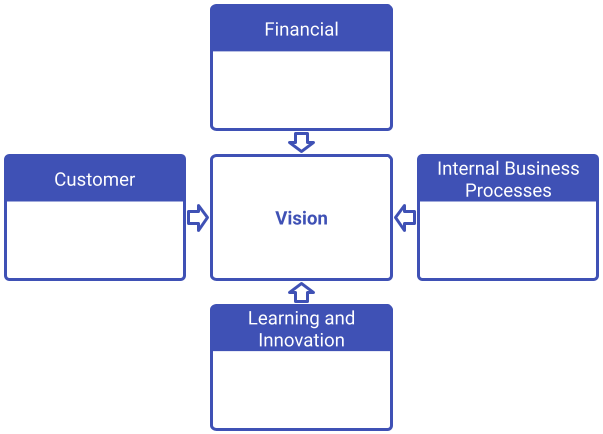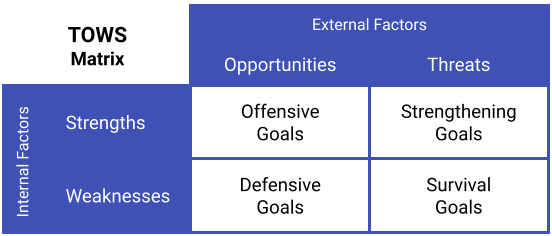The role of goals in strategy
Goals are how we articulate strategic direction. They describe different aspects of where an organisation needs to go or to improve in order to be successful.
How we describe goals
The best goal statements tend to consist of a verb (an action word/phrase) followed by a noun (a word/phrase that describes a thing). For example:
- Increase(verb) customer sasfaction with after sales service(noun)
- Improve(verb) production line up time(noun)
Goals expressed in this way have the effect of commanding action to be taken.
Goals should also be directional and don't need to be measurable. They will be broken down into SMART (Specific, Measurable, Achievable, Relevant and Timebound) objectives later.
Using the Balanced Scorecard to set goals
 We can use the Balanced Scorecard to help us set well-balanced and integrated goals.
We can use the Balanced Scorecard to help us set well-balanced and integrated goals.
The Balanced Scorecard advocates for setting goals across 4 perspectives:
- Financial: What success looks like financially (to owners)
- Customer: What success looks like to customers.
- Internal Business Processes: What internal business process performance must we achieve to be successful?
- Learning and Innovation: What do we need to do to be able to achieve the above on a sustainable basis?
The theory of the Balanced Scorecard is that success in each layer helps to achieve success in the layers above it. You can learn more about the Balanced Scorecard here.
Using TOWS to set goals
You can use the strategic insights on your SWOT Analysis to help you set strategic goals using the TOWS framework as follows:
 Offensive Goals (SO): use strengths to take advantage of opportunities.
Offensive Goals (SO): use strengths to take advantage of opportunities.- Defensive Goals (WO): choose opportunities which don't rely on capabilities which are weak.
- Strengthening Goals (ST): use strengths to minimise threats.
- Survival Goals (WT): minimise weaknesses and avoid threats.
Our #stratBot AI can use the TOWS framework to suggest Strategic Goals for you.
Where to find Goals
You can find and set your Goals in the Direction section of StratNavApp.com:
- Sign in (or sign up) to StratNavApp.com.
- Select the project you want to work with.
- Click on "Direction" on the main menu.
- Select "Goals" on the Selector at the top of the page that follows.
- Select either the Balanced Scorecard view, or the RASCI view which provides a stakeholder perspective on your goals.
You can also find your goals:
- On the Goal/Initiative Matrix in the Planning section,
and - On your Strategy Scorecard in the Results section.
Breaking Strategic Goals down into Objectives and KPIs
Your Strategic Goals set long-term direction.
You can then break this down into SMART and more medium-term Objectives which can be tracked using Key Performance Indicators (KPIs) with targets.
Through these links, KPIs show progress towards Strategic Goals.
Linking Goals within your Strategy
You can link Goals to:
- Strategic Insights, to illustrate why the goals are important.
- Initiatives (or Actions), to show how you will achieve them.
- Stakeholders (people or organisations), to show who is Accountable, Responsible, etc. for them.
The key to achieving goals: alignment
Unless you are a solopreneur and working entirely alone, the key to achieving your strategic goals is alignment.
Alignment means getting many people to work together towards shared goals.
Alignment is the opposite of the siloed approach, where people work separately on their own goals.
How do you get people to work together towards shared goals? By telling them why those goals make sense.
And the answer to the question why? is to be found in your strategic analysis. Because if people don't agree on the facts of the challenges and opportunities they face, and the resrouces they have at their disposal, then they are very unlikely to agree on the goals to overcome and realise them.
In simpler terms, if they don't agree on what the problem is, they will never agree on what the solution is.
What to do when your Strategic Goals change
Strategic Goals shouldn't change very often.
If they do, it might be a warning sign:
-
You could be jumping from one priority to the next before giving the first one time to show results. That’s like planting a tree, then pulling it up and planting a new one before it’s had a chance to grow fruit.
-
Your team (and even your customers) may get confused about what really matters.
-
Your strategy might be too shallow—chasing trends instead of focusing on long-term insights.
But sometimes, change is necessary. If your strategic goals need to shift, you can:
-
Update a goal to better fit your new direction.
-
Remove a goal that’s no longer relevant.
-
Add a new goal that reflects your current priorities.
💡 Just don’t forget: When you change a goal, check how it affects the related Objectives, KPIs and Targets. Everything needs to stay aligned.
